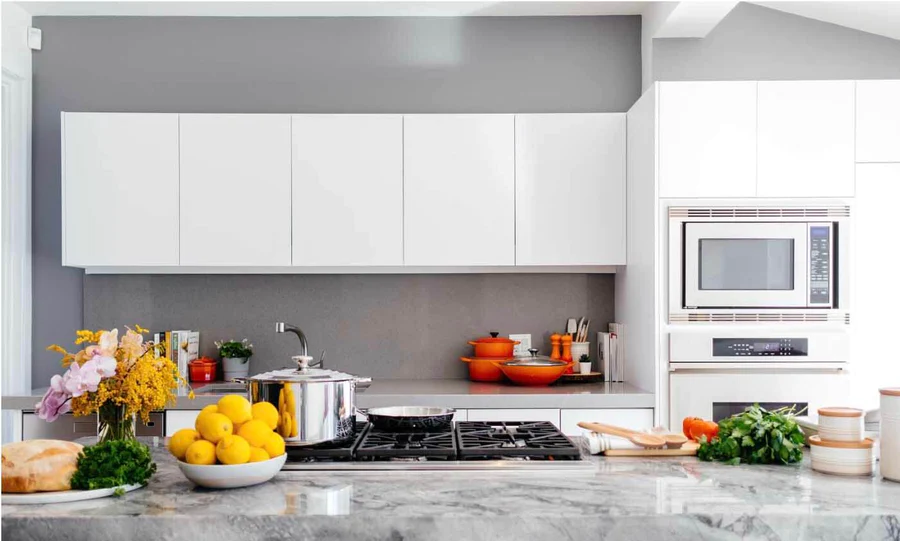Table of Contents
Many of our kitchens have become hotspots for overconsumption and waste. All you need to do is take a look in your refrigerator, cupboard, or trash bin to see how many single use products find their way into your kitchen. While the amount of waste we make in our kitchen is shocking, there are simple steps you can take to create an eco-friendly kitchen. Follow the four steps below to help the environment, reduce clutter, and work towards a zero waste kitchen!
Step 1: Remove Plastic Bags From Your Kitchen

While you likely know plastic bags are bad for the environment, you may not know the extent of their damage. For starters, every year people consume more than 500 billion plastic bags worldwide. What makes this even more frustrating is that we only recycle 9% of the plastic we consume. That means most plastic is used once then discarded!
Too many people use plastic bags to bring their groceries from the store to their kitchen. Thankfully, there’s a solution to the plastic bag problem that prevents so many people from enjoying an eco-friendly kitchen. That solution is to invest in a set of organic cotton tote bags. Next time your cashier asks you “paper or plastic”, proudly hand them a reusable cotton bag to hold your groceries.
Plastic produce bags are another source of waste in your kitchen. If you want to make another stride towards a zero waste kitchen I suggest getting some reusable produce bags. Organic cotton bags are the ultimate eco friendly product that should be in every sustainable kitchen. Cotton bags are not only better for the environment, but are also bigger and sturdier than the flimsy produce bags you get at the store!
Step 2: Start Bulk Bin Shopping

Bulk shopping is a fantastic way to both save money at the store and build an eco friendly kitchen. Many supermarkets, especially health food stores, have bulk bin sections where you can buy dry goods such as grains, nuts, and spices without wasteful plastic packaging that gets in the way of a zero waste kitchen.
In order to truly go zero waste in the bulk bin section you must shop with reusable containers. If you want to be cost effective you can reuse kitchen jars as homemade eco-friendly containers for your food.
Before you go to the store, weigh your jar and find the “tare weight”. The “tare weight” is the weight of your container without food in it. This weight will be subtracted from your purchase at the store, once you fill your jar up with goodies!
If you want to really speed up the process, you can use reusable bulk food bags for bulk bin purposes. Cotton bags have the tare weight on their label, so you don’t need to weigh them. They’re also light, cheap, and easy to bring with you to the store and back to your eco-friendly kitchen!
If you don’t know where to go bulk bin shopping in your area, I suggest your local health or organic grocers. Bulk bins are especially common at these types of stores. There are also online resources you can use to find stores with bulk bins. My two favorites are The Zero Waste Home App and Litterless’s list of bulk bin locations.
Step 3: Ditch Paper Cleaning Products In Your Kitchen

Paper towels, napkins, and other single use cleaning products have no place in an eco-friendly kitchen. Before I made a commitment to zero-waste living, I used to spend close to a hundred dollars a year on paper towels alone! Not only were they expensive, but they ended up right in the trash can after a single use. That’s not what you want if you’re trying to go zero waste in the kitchen!
With so many eco-friendly alternatives, there is simply no need to buy single use paper products for your kitchen. Instead of constantly buying paper napkins, why not purchase cloth napkins which you can wash and reuse again and again. Instead of buying paper towels, it’s much cheaper to buy eco friendly kitchen products like microfiber dish rags.
If you’re feeling adventurous you can turn this step into a fun DIY project! There are many easy zero waste swaps for paper towels and napkins. One of my favorites from this list is to cut up old clothes and bed sheets and use them as homemade kitchen rags. There are a ton of other items you can repurpose for your zero waste kitchen. This is your chance to get creative!
Step 4: Cook More Homemade Recipes

Cooking from scratch is a delicious way to build an eco-friendly kitchen. Processed and pre-made foods often come in wasteful single use packaging that’s terrible for the environment. Homemade recipes are not only more sustainable, but they taste better than the cookie-cutter items you find at the grocery store!
Some of my favorite homemade recipes are for common kitchen sauces and condiments like ketchup, mustard, and salad dressing. Check out some delicious waste free recipes for these condiments. Once you finish a recipe, store it in a reusable container. Something as simple as an old glass jar works great! This helps cut out plastic waste from your eco-friendly kitchen.
If you want to take things a step further you can also make foods like bread and pasta from scratch. Check out these zero waste recipes for baking bread and making homemade pasta. These help you reduce waste in your kitchen and are also fun foody projects you can do with friends who are also working towards a zero waste kitchen!
If you’re committed to a more eco-conscious life, then the kitchen is the perfect place to start. Creating an eco friendly kitchen is a bold move towards a sustainable future. Use the four steps above to help you reduce waste and move forward in your goal of a zero waste kitchen and a zero waste life!
